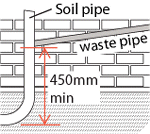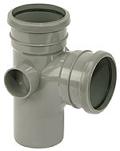Connecting waste pipes to the drains
Taking the waste pipe through the wall.
Joining to a stack pipe.
Feeding into a gully.
Cutting the pipe.
This article is intended to give guidance for connecting 32 and 40mm waste pipe to the existing foul water drainage of the property. The options are usually:
- Connecting to the stack pipe,
- Feeding to a ground level gully,
or
- Feeding into an existing hopper on a down pipe.
Each unit discharging water must have a waste trap in the pipe before it enters the stack or discharges into a gully or hopper. Typical water traps are:
| Appliance | Diameter of trap (mm) | Depth of water seal |
| Basin |
32 | 75 |
| Baths *
Showers * |
40 | 50 |
| Sink
Food Waste Disposal Washing machine * Dish washer * |
40 | 75 |
* Where these units discharge directly into a hopper or gully, the depth of water seal may be reduced to 38mm.
Where there is insufficient space under the appliance to accommodate the required size trap, a running trap may be fitted into the waste pipe run.
Modern regulations require waste water from above ground level to join into the stack pipe, however with the replacement of baths etc where the original waste fed into a hopper, this method may be reused.
At ground level, the waste pipe may feed into a gully connected to the foul water drain - but not a soakaway.
When planning the pipe run, work out the best route for the waste pipe from the new appliance to the drain - either the stack pipe, gully or hopper (if previously used).
All the pipe runs must have a downhill slope to avoid water collecting in the run, allow for at least a 18mm fall in for every metre of pipe run.
Leave making the connections and fixing the waste pipe to the walls until you have cut all the pipework and checked the fitting, runs and falls.
Our other article dealing with the different types of plastic waste pipes and connectors will also be of help.
Taking the waste pipe through the wall.
Having decided where the pipe will go through the wall, carefully check, both inside and out, that there are no obstructions in the way, i.e. cables, pipes etc. It is sometimes difficult to estimate exactly where a hole drilled from the inside will exit on the outside wall, so 'measure twice, drill once' or leave a margin so that if you misjudge it by a small amount, it won't cause any problem.
The easiest way to cut the hole for the pipe through the wall is to use a diamond tipped core drill, these can often be hired just for the job.
Alternatively, mark the circumference of the pipe on the internal wall and use a masonry drill to drill a series of closely spaced holes around the mark, then use a hammer and cold chisel to remove the centre.
Internally, the hole can probably be larger that absolutely necessary as the wall can be made good and redecorated afterwards.
Externally, it is sometimes neater to remove a brick and then cut and replace it after the pipework has been completed.
Joining to a stack pipe.
Every appliance feeding waste water into a stack must have its own waste trap to provide a water seal (see above).
To ensure that the water seal is maintained, the slope and size of the waste pipe connecting it to the stack pipe depends upon the length of the pipe run, typical figures are:
| Diameter of waste pipe | Maximum length between trap and stack pipe | Fall per metre run | |
| Sink | 40mm | 3m | 18 to 90mm |
| 50mm | 4m | 18 to 90mm | |
| Basin | 32mm | 1.7m | 18 to 22mm |
| 40mm | 3m | 18 to 44mm | |
| Bath | 40mm | 3m | 18 to 90mm |
| 50mm | 4m | 18 to 90mm |
 Stack
pipes should not be joined into less than 450mm above the bottom of the bend at the bottom on the stack pipe underground. This
cannot always be determined, however unless connecting for a ground floor waste, this is unlikely to be a problem.
Stack
pipes should not be joined into less than 450mm above the bottom of the bend at the bottom on the stack pipe underground. This
cannot always be determined, however unless connecting for a ground floor waste, this is unlikely to be a problem.
 Where
running one end of a waste pipe into a stack pipe, fit an access fitting with a detachable cover at the opposite end to enable
any blockage to be cleared if necessary.
Where
running one end of a waste pipe into a stack pipe, fit an access fitting with a detachable cover at the opposite end to enable
any blockage to be cleared if necessary.
The method used to join into a stack pipe depends on what already existing:
 For a
plain round stack pipe, use a strap on boss, as the name suggests, these are straps incorporating a boss to accept the additional
waste pipe. A hole is cut in the stack pipe to locate the strap and allow free passage of the waste. Three methods of fixing the
strap are available:
For a
plain round stack pipe, use a strap on boss, as the name suggests, these are straps incorporating a boss to accept the additional
waste pipe. A hole is cut in the stack pipe to locate the strap and allow free passage of the waste. Three methods of fixing the
strap are available:
- Screw strap where the ends of the band meet and are secured together by a nut and bolt.
- Easy fix strap where the ends of the band meet and just click together.
- Bonded strap where the two arms of the strap are bonded to the stack pipe - this needs the stack pipe to be of suitable material.
The strap needs to be fitted the correct way up, they are normally marked 'top' in one position. On some existing stack pipes, there may be moulded bosses to accept addition connections (as shown right). Special inserts need to be purchased to fit these bosses, the pipe at the back of the boss on the stack pipe is cut away, and the insert fitted, normally glued, in place. The insert needs to be inserted the correct way up, they are normally marked 'top' on one side.
On some existing stack pipes, there may be moulded bosses to accept addition connections (as shown right). Special inserts need to be purchased to fit these bosses, the pipe at the back of the boss on the stack pipe is cut away, and the insert fitted, normally glued, in place. The insert needs to be inserted the correct way up, they are normally marked 'top' on one side.
Feeding into a gully.
The gully used must be connected to the foul water drainage, not a soakaway.
If there is doubt whether a gully is connected to the foul water drain, lift the manhole cover nearest to the main sewer (or cess pit, septic tank) to expose the inspection chamber underneath. Then pour a bucket of water down the gully. If water flows through the exposed chamber, the gully is feeding into the foul water drains; if water does not flow, the probability is that the gully is connected to a soakaway and should not be used to dispose of household water.
 With gullies, it is necessary to terminate the waste pipe below the grating, but above the water level inside.
With gullies, it is necessary to terminate the waste pipe below the grating, but above the water level inside.
Cutting pipe.
Waste pipe should be cut as near square as possible, so always hold it on a firm surface where it can be firmly held. Wrapping a piece of paper around the pipe so that the edge of the paper lines up will act as a guide to cut square.
Use a file to remove the swarf and rough edges from both the outside and inside of the pipe before fitting it into any connector.
